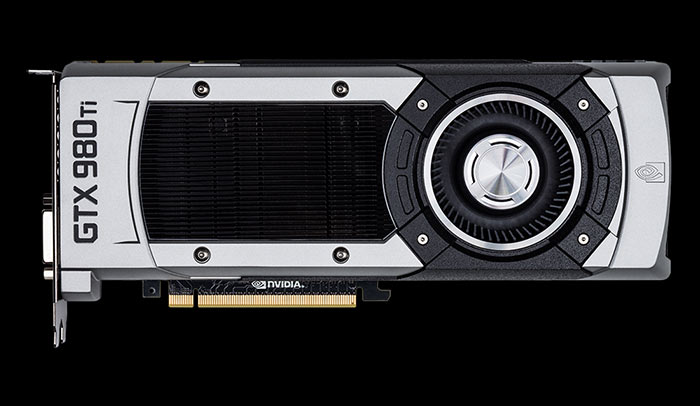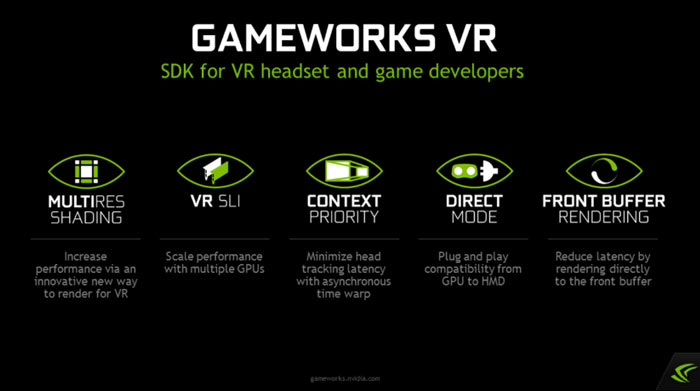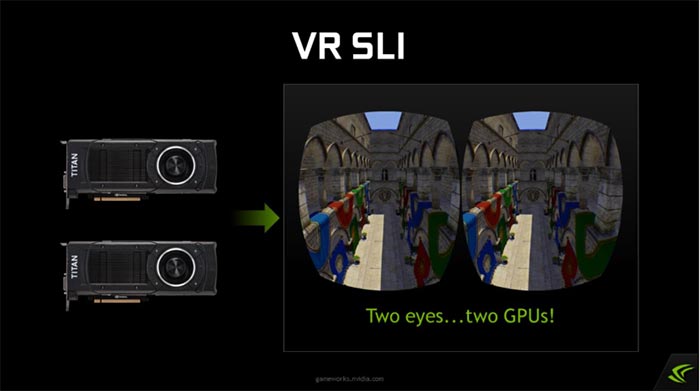Die neue Nvidia GeForce 980-Ti soll die Grafikkarte der ersten Wahl werden wenn es in Zukunft um virtuelle Realität auf dem PC geht.
Das zumindest so scheint es, verspricht sich Nvidia von ihrer neuen Grafikkarte die wohl auch deshalb eng zusammen mit der neuen Gameworks VR SDK für Entwickler bekanntgegeben wurde. Die Spezifikationen der GTX 980-TI lesen sich auf den ersten Blick zumindest hervorragend.
Die Grafikkarte für die virtuelle Realität?
Nach dem unrühmlichen Desaster den Nvidia zuletzt mit dem Arbeitsspeicher ihrer GeForce 970er Baureihe hatte lässt sich diesmal nur hoffen das die Spezifikationen, die gestern zur Nvidia GeForce 980-Ti bekanntgegeben wurden diesmal auch wirklich in allen Punkten zutreffen werden.
Zu den großen Eckdaten gehören 6 Gigabyte an DDR5 Ram über den die Grafikkarte verfügt, außerdem 2816 Cuda Kerne und eine maximal unterstützte Auflösung von 5120 x 3200 Bildpunkten.

Im unterschied zur normalen GeForce 980 die mit nur 2048 Cuda Kernen arbeitet verfügt die Ti Variante hier zum Beispiel über knapp 800 Cuda Kerne mehr. Die Leistungsfähigkeit der Grafikkarte wird auf dem Blog von Nvidia in etwa mit der dreifachen Rechenleistung einer herkömmlichen GeForce 680 verglichen.
Die Spezifikationen der GeForce 980-TI in der Übersicht.
Engine Specs:
2816 CUDA Cores
1000 Base Clock (MHz)
1075 Boost Clock (MHz)
176 Texture Fill Rate (GigaTexels/sec)
Memory Specs:
7.0 GbpsMemory Clock
6 GB Standard Memory Config
GDDR5 Memory Interface
384-bit Memory Interface Width
336.5 Memory Bandwidth (GB/sec)
Technology Support:
(4-way)NVIDIA SLI® Ready
NVIDIA G-Sync™-Ready
NVIDIA GameStream™-Ready
GeForce ShadowPlay™
2.0 NVIDIA GPU Boost™
Super Resolution Technology
NVIDIA GameWorks™
API with Feature Level 12.1Microsoft DirectX
4.5 OpenGL
CUDA
PCI Express 3.0 Bus Support
Windows 8 & 8.1, Windows 7, Windows Vista, Linux, FreeBSD x86OS Certification
Display Support:
5120x3200Maximum Digital Resolution*
2048x1536Maximum VGA Resolution
Dual Link DVI-I, HDMI, 3x DisplayPort 1.2 Standard Display Connectors
4 displaysMulti Monitor
HDCP
HDMI
InternalAudio Input for HDMI
GTX 980 TI Graphics Card Dimensions:
4.376 inchesHeight
10.5 inchesLength
Dual-widthWidth
Thermal and Power Specs:
92 CMaximum GPU Tempurature (in C)
250 WGraphics Card Power (W)
600 WMinimum System Power Requirement (W)
6-pin + 8-pinSupplementary Power Connectors
Neben der Grafikkarte, der Geforce 980-Ti wurde ausserdem eine Entwickler SDK mit dem Namen Gameworks VR angekündigt.
Was ist Gameworks VR?
Direct VR oder auch Gameworks VR ist ein Palette an Entwicklertools und Verfahren die bei der Erzeugung von virtuellen Welten und der Latenzfreien bzw. schnellen Kommunkation zwichen PC, DirectX12, Grafikarte und VR Brillen hilfreich oder notwendig sind.
Gameworks VR beinhaltet:
- NVIDIA Multi-Res Shading (MRS) — An innovative new rendering technique for VR. With NVIDIA MRS, each part of an image is rendered at a resolution that better matches the pixel density of the final displayed VR image. This technology uses the multi-projection architecture of the GeForce GTX 980 Ti GPU to render multiple viewports in a single pass. The result: substantial performance improvements for VR games.
- VR SLI — Provides increased performance for VR apps. Multiple GPUs can be assigned a specific eye to dramatically accelerate stereo rendering. With the GPU affinity application programming interface, VR SLI allows scaling for PCs with two or more GPUs.
- Context Priority — Enables control over GPU scheduling to support advanced VR features such as asynchronous time warp. This cuts latency and quickly adjusts images as gamers move their heads, without the need to re-render a new frame.
- Direct Mode — Delivers plug-and-play compatibility for VR headsets. With Direct Mode, the NVIDIA graphics driver recognizes the headset as a VR display rather than a standard desktop monitor, providing a more seamless user experience.
- Front Buffer Rendering — Lets the GPU to render directly to the front buffer to reduce latency.
- NVIDIA Multi-Res Shading (MRS) — An innovative new rendering technique for VR. With NVIDIA MRS, each part of an image is rendered at a resolution that better matches the pixel density of the final displayed VR image. This technology uses the multi-projection architecture of the GeForce GTX 980 Ti GPU to render multiple viewports in a single pass. The result: substantial performance improvements for VR games.
- VR SLI — Provides increased performance for VR apps. Multiple GPUs can be assigned a specific eye to dramatically accelerate stereo rendering. With the GPU affinity application programming interface, VR SLI allows scaling for PCs with two or more GPUs.
- Context Priority — Enables control over GPU scheduling to support advanced VR features such as asynchronous time warp. This cuts latency and quickly adjusts images as gamers move their heads, without the need to re-render a new frame.
- Direct Mode — Delivers plug-and-play compatibility for VR headsets. With Direct Mode, the NVIDIA graphics driver recognizes the headset as a VR display rather than a standard desktop monitor, providing a more seamless user experience.
- Front Buffer Rendering — Lets the GPU to render directly to the front buffer to reduce latency.
- NVIDIA Multi-Res Shading (MRS) — An innovative new rendering technique for VR. With NVIDIA MRS, each part of an image is rendered at a resolution that better matches the pixel density of the final displayed VR image. This technology uses the multi-projection architecture of the GeForce GTX 980 Ti GPU to render multiple viewports in a single pass. The result: substantial performance improvements for VR games.
- VR SLI — Provides increased performance for VR apps. Multiple GPUs can be assigned a specific eye to dramatically accelerate stereo rendering. With the GPU affinity application programming interface, VR SLI allows scaling for PCs with two or more GPUs.
- Context Priority — Enables control over GPU scheduling to support advanced VR features such as asynchronous time warp. This cuts latency and quickly adjusts images as gamers move their heads, without the need to re-render a new frame.
- Direct Mode — Delivers plug-and-play compatibility for VR headsets. With Direct Mode, the NVIDIA graphics driver recognizes the headset as a VR display rather than a standard desktop monitor, providing a more seamless user experience.Front Buffer Rendering — Lets the GPU to render directly to the front buffer to reduce latency.
Weitere und genauere Infos finden sich im Final Handout:
https://developer.nvidia.com/sites/default/files/akamai/gameworks/vr/GameWorks_VR_2015_Final_handouts.pdf












